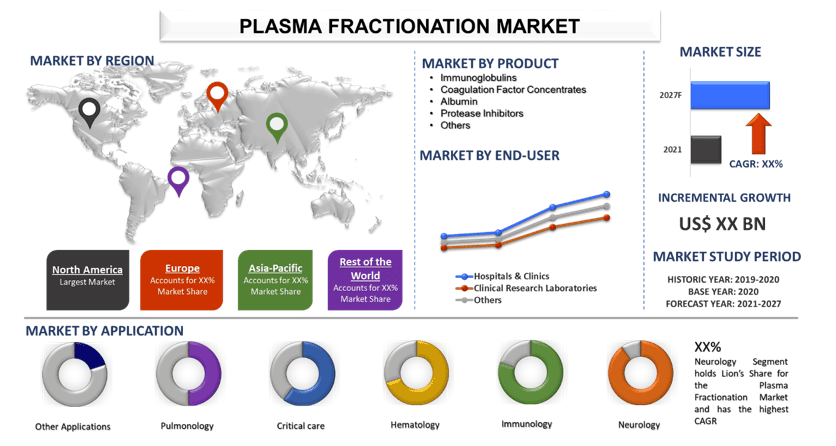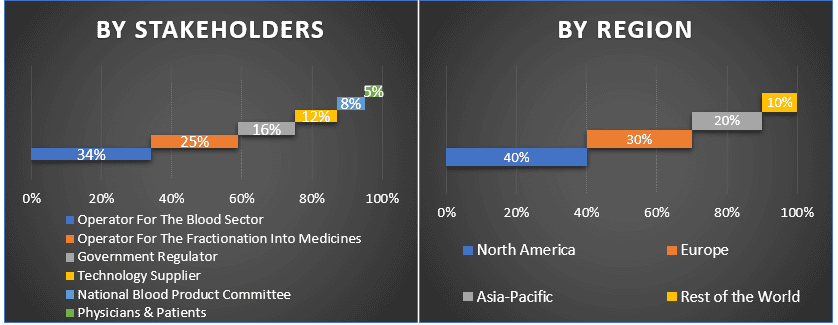- Strona główna
- O nas
- Branża
- Usługi
- Czytanie
- Kontakt
Rynek frakcjonowania osocza: aktualna analiza i prognoza (2021-2027)
Produkt (Immunoglobuliny, Koncentraty Czynników Krzepnięcia, Albumina, Inhibitory Proteaz, Inne); Zastosowanie (Neurologia, Immunologia, Hematologia, Intensywna terapia, Pulmonologia, Inne); Użytkownik Końcowy (Szpitale i Kliniki, Laboratoria Badań Klinicznych, Inni); Region i Kraj

Oczekuje się, że rynek frakcjonowania osocza przekroczy wartość rynkową ponad 43 miliardów USD w 2027 roku i będzie rósł ze znaczącym CAGR na poziomie ~6% w okresie prognozy (2021-2027). Produkty białkowe frakcjonowane z ludzkiego osocza są zasadniczą klasą środków terapeutycznych stosowanych, często jako jedyna dostępna opcja, w profilaktyce, leczeniu i opanowywaniu stanów zagrażających życiu wynikających z urazów, wrodzonych niedoborów, zaburzeń immunologicznych lub infekcji. Nowoczesna technologia produkcji produktów osoczowych w dużej mierze opiera się na procesie frakcjonowania etanolem, ale w ciągu ostatnich kilku lat wiele się zmieniło, aby poprawić czystość produktu, zwiększyć odzyskiwanie immunoglobulin G i wyizolować nowe białka osocza, takie jak inhibitor α1-proteazy, czynnik von Willebranda i białko C. Ze względu na ludzkie pochodzenie materiału wyjściowego i łączenie od 10 000 do 50 000 donacji wymaganych do przetwarzania przemysłowego, głównym ryzykiem związanym z produktami osoczowymi jest przenoszenie infekcyjnych czynników zakaźnych przenoszonych przez krew. Większość metod oddzielania białek osocza krwi opiera się na początkowej zmianie właściwości fizycznych i chemicznych osocza lub związków w nim zawartych. Ta zmiana właściwości prowadzi do zmiany rozpuszczalności, a ostatecznie do wytrącania się docelowych białek osocza w roztworze ciekłego osocza. W niektórych przypadkach wytrącanie białek osocza uzyskuje się poprzez kontrolowaną zmianę temperatury, zwaną krioprecypitacją. Większość wytrącania białek wymaga dodania środka wytrącającego lub separującego. Po wytrąceniu się białka można je wyizolować metodami mechanicznymi lub chemicznymi.
Globalny rynek frakcjonowania osocza jest napędzany przez szybko rosnącą populację światową. Doprowadziło to do nasilenia presji na naturalne zasoby wodne. W konsekwencji konsumenci odchodzą od naturalnych zasobów wodnych na rzecz magazynowania wody za pomocą różnych skutecznych środków, takich jak frakcjonowanie osocza, aby utrzymać poziom wód gruntowych pod kontrolą. Co więcej, ze względu na minimalną konserwację, łatwy proces instalacji i dostępność w szerokim zakresie rozmiarów i typów zbiorników, frakcjonowanie osocza staje się jednym z najpopularniejszych i najczęściej stosowanych mechanizmów gromadzenia wody na całym świecie. Ponadto rządy wielu krajów promują kampanie i inicjatywy mające na celu zachęcanie do przyjmowania frakcjonowania osocza zarówno w sektorze krajowym, jak i przemysłowym. Oferują również ulgi podatkowe i zachęty do korzystania z tych systemów; na przykład inwestycje rządu Indii w budowę licznych struktur frakcjonowania osocza na obszarach wiejskich i miejskich kraju, co ma pomóc w równym rozmieszczeniu i dostępności wody pitnej. Oczekuje się, że zmniejszająca się ilość słodkiej wody przyspieszy rozwój branży w okresie prognozy.
Globalna objętość osocza krwi do frakcjonowania (w milionach litrów), 1990 do 2018

Baxter International Inc., Bio product laboratory, Biotest AG, CSL Ltd., Grifols SA, Kedrion S.P.A (Kedrion Biopharma Inc.), LFB S. A., Octapharma AG, Sanquin Blood Supply Foundation i Takeda Pharmaceutical Company Limited to jedni z czołowych graczy działających na rynku frakcjonowania osocza. Gracze ci podejmują szereg fuzji i przejęć wraz z partnerstwami, aby ułatwić klientom korzystanie z zaawansowanych technologicznie i innowacyjnych produktów/technologii.
Informacje przedstawione w raporcie
„Spośród produktów, segment immunoglobulin posiada największy udział”
Na podstawie produktu rynek frakcjonowania osocza jest podzielony na immunoglobuliny, koncentraty czynników krzepnięcia, albuminę, inhibitory proteaz i inne. Immunoglobuliny pochodzące z osocza nadają nową narrację opiece zdrowotnej w szerokim zakresie autoimmunologicznych chorób zapalnych. Klinicznie istotne przeciwciała specyficzne immunoglobuliny obejmują immunoglobuliny anty-D (anty-Rho) oraz antyHAV, anty-HBs, anty-tężcowe, anty-varicella/herpes zoster i anty-wściekliznowe.
„Spośród zastosowań, segment neurologiczny posiada największy udział”
Na podstawie zastosowania rynek frakcjonowania osocza jest podzielony na neurologię, immunologię, hematologię, intensywną terapię, pulmonologię i inne. Największy udział w tym segmencie przypisuje się głównie rosnącym zaburzeniom neurologicznym, które wymagają produktów frakcjonowania osocza, oraz rosnącym badaniom nad produktami pochodzącymi z osocza w chorobach neurologicznych. Dodatkowo, czynnikiem napędzającym jest również reakcja IVIg w krótszym czasie niż sterydy lub doustne leki immunosupresyjne oraz jej skuteczność w wielu zaburzeniach obwodowego i ośrodkowego układu nerwowego.
„Ameryka Północna reprezentuje jeden z największych rynków frakcjonowania osocza”
Aby lepiej zrozumieć dynamikę rynku frakcjonowania osocza, przeprowadzono szczegółową analizę dla różnych regionów na świecie, w tym Ameryki Północnej (USA, Kanada, reszta Ameryki Północnej), Europy (Niemcy, Wielka Brytania, Francja, Hiszpania, Włochy, reszta Europy), Azji i Pacyfiku (Chiny, Japonia, Indie, Australia, reszta Azji i Pacyfiku), reszty świata. Ameryka Północna zdominowała rynek i zdobyła około XX% udziału w rynku ze względu na rosnącą liczbę chorób przewlekłych i populację geriatryczną.
Powody, dla których warto kupić ten raport:
- Badanie obejmuje analizę wielkości rynku i prognozowania zweryfikowaną przez uwierzytelnionych kluczowych ekspertów branżowych
- Raport przedstawia szybki przegląd ogólnej wydajności branży na pierwszy rzut oka
- Raport obejmuje dogłębną analizę wybitnych konkurentów z branży, z głównym naciskiem na kluczowe dane finansowe firmy, portfolio produktów, strategie ekspansji i najnowsze osiągnięcia
- Szczegółowe badanie czynników napędzających, ograniczeń, kluczowych trendów i możliwości występujących w branży
- Badanie kompleksowo obejmuje rynek w różnych segmentach
- Dogłębna analiza regionalna branży
Opcje dostosowywania:
Rynek frakcjonowania osocza można dodatkowo dostosować zgodnie z wymaganiami lub dowolnym innym segmentem rynku. Poza tym UMI rozumie, że możesz mieć własne potrzeby biznesowe, dlatego możesz skontaktować się z nami, aby otrzymać raport, który w pełni odpowiada Twoim wymaganiom.
Spis treści
Analiza historycznego rynku, oszacowanie obecnego rynku i prognozowanie przyszłego rynku frakcjonowania osocza to trzy główne kroki podjęte w celu stworzenia i przeanalizowania adaptacji frakcjonowania osocza w głównych regionach na całym świecie. Przeprowadzono wyczerpujące badania wtórne w celu zebrania danych historycznych dotyczących rynku i oszacowania obecnej wielkości rynku. Po drugie, aby zweryfikować te spostrzeżenia, wzięto pod uwagę liczne ustalenia i założenia. Ponadto przeprowadzono również wyczerpujące wywiady pierwotne z ekspertami branżowymi w całym łańcuchu wartości rynku frakcjonowania osocza. Po założeniu i walidacji danych rynkowych poprzez wywiady pierwotne zastosowaliśmy podejście odgórne/oddolne do prognozowania całkowitej wielkości rynku. Następnie przyjęto metody podziału rynku i triangulacji danych w celu oszacowania i analizy wielkości rynku segmentów i podsegmentów, których dotyczy branża. Szczegółowa metodologia jest wyjaśniona poniżej:
Uzyskaj więcej informacji o metodologii badań
Analiza historycznej wielkości rynku
Krok 1: Dogłębne badanie źródeł wtórnych:
Przeprowadzono szczegółowe badanie wtórne w celu uzyskania historycznej wielkości rynku frakcjonowania osocza poprzez wewnętrzne źródła firmy, takie jak raport roczny i sprawozdania finansowe, prezentacje wyników, komunikaty prasowe itp., oraz zewnętrzne źródła, w tym czasopisma, wiadomości i artykuły, publikacje rządowe, publikacje konkurencji, raporty sektorowe, bazy danych stron trzecich i inne wiarygodne publikacje.
Krok 2: Segmentacja rynku:
Po uzyskaniu historycznej wielkości rynku frakcjonowania osocza przeprowadziliśmy szczegółową analizę wtórną w celu zebrania historycznych spostrzeżeń rynkowych i udziałów dla różnych segmentów i podsegmentów dla głównych regionów. Główne segmenty uwzględnione w raporcie to produkt, zastosowanie i użytkownik końcowy. Przeprowadzono dalsze analizy na poziomie krajowym w celu oceny ogólnej adaptacji frakcjonowania osocza w danym regionie.
Krok 3: Analiza czynnikowa:
Po uzyskaniu historycznej wielkości rynku różnych segmentów i podsegmentów przeprowadziliśmy szczegółową analizę czynnikową w celu oszacowania obecnej wielkości rynku frakcjonowania osocza. Ponadto przeprowadziliśmy analizę czynnikową przy użyciu zmiennych zależnych i niezależnych, takich jak wzrost chorób przewlekłych i populacja geriatryczna. Przeprowadzono dogłębną analizę scenariuszy popytu i podaży, biorąc pod uwagę najważniejsze partnerstwa, fuzje i przejęcia, ekspansję biznesową i wprowadzenie produktów na rynek w sektorze frakcjonowania osocza na całym świecie.
Szacunek i prognoza obecnej wielkości rynku
Określanie obecnej wielkości rynku: W oparciu o praktyczne spostrzeżenia z powyższych 3 kroków doszliśmy do obecnej wielkości rynku, kluczowych graczy na rynku frakcjonowania osocza i udziałów rynkowych segmentów. Wszystkie wymagane udziały procentowe i podziały rynku zostały określone przy użyciu wspomnianego powyżej podejścia wtórnego i zostały zweryfikowane poprzez wywiady pierwotne.
Szacowanie i prognozowanie: Do szacowania i prognozowania rynku przypisano wagi różnym czynnikom, w tym czynnikom napędzającym i trendom, ograniczeniom i możliwościom dostępnym dla interesariuszy. Po przeanalizowaniu tych czynników zastosowano odpowiednie techniki prognozowania, tj. podejście odgórne/oddolne, aby dojść do prognozy rynkowej na około 2027 r. dla różnych segmentów i podsegmentów na głównych rynkach na całym świecie. Metodologia badawcza przyjęta do oszacowania wielkości rynku obejmuje:
- Wielkość rynku branży, pod względem wartości (USD) i wskaźnik adaptacji frakcjonowania osocza na głównych rynkach krajowych
- Wszystkie udziały procentowe, podziały i zestawienia segmentów i podsegmentów rynku
- Kluczowi gracze na rynku frakcjonowania osocza pod względem oferowanych produktów. Ponadto strategie wzrostu przyjęte przez tych graczy, aby konkurować na szybko rozwijającym się rynku
Walidacja wielkości i udziału w rynku
Badania pierwotne: Przeprowadzono dogłębne wywiady z kluczowymi liderami opinii (KOL), w tym z kadrą kierowniczą najwyższego szczebla (CXO/VP, szef sprzedaży, szef marketingu, szef operacyjny i szef regionalny, szef kraju itp.) w głównych regionach. Wyniki badań pierwotnych zostały następnie podsumowane, a analiza statystyczna została przeprowadzona w celu udowodnienia postawionej hipotezy. Dane wejściowe z badań pierwotnych zostały połączone z wynikami wtórnymi, przekształcając w ten sposób informacje w praktyczne spostrzeżenia.
Podział uczestników pierwotnych w różnych regionach

Inżynieria rynku
Zastosowano technikę triangulacji danych, aby ukończyć ogólne oszacowanie rynku i dojść do dokładnych danych statystycznych każdego segmentu i podsegmentu rynku frakcjonowania osocza. Dane zostały podzielone na kilka segmentów i podsegmentów po przestudiowaniu różnych parametrów i trendów w obszarach typu i ich typu rynku frakcjonowania osocza.
Główny cel badania rynku frakcjonowania osocza
W badaniu wskazano obecne i przyszłe trendy rynkowe frakcjonowania osocza. Inwestorzy mogą uzyskać strategiczne spostrzeżenia, na których mogą oprzeć swoją decyzję o inwestycjach, na podstawie analizy jakościowej i ilościowej przeprowadzonej w badaniu. Obecne i przyszłe trendy rynkowe określiły ogólną atrakcyjność rynku na poziomie regionalnym, zapewniając uczestnikom przemysłowym platformę do wykorzystania niewykorzystanego rynku w celu uzyskania korzyści jako pierwszy podmiot. Inne ilościowe cele badań obejmują:
- Analiza obecnej i prognozowanej wielkości rynku frakcjonowania osocza pod względem wartości (USD). Ponadto analiza obecnej i prognozowanej wielkości rynku różnych segmentów i podsegmentów
- Segmenty w badaniu obejmują obszary typu i ich podtypy
- Definicja i analiza ram regulacyjnych dla branży frakcjonowania osocza
- Analiza łańcucha wartości związanego z obecnością różnych pośredników, wraz z analizą zachowań klientów i konkurentów branży
- Analiza obecnej i prognozowanej wielkości rynku frakcjonowania osocza dla głównego regionu
- Główne regiony badane w raporcie to Ameryka Północna (USA, Kanada, Reszta Ameryki Północnej), Europa (Niemcy, Wielka Brytania, Francja, Hiszpania, Włochy, Reszta Europy), Azja i Pacyfik (Chiny, Japonia, Indie, Australia, Reszta Azji i Pacyfiku), Reszta Świata.
- Profile firm na rynku frakcjonowania osocza i strategie wzrostu przyjęte przez uczestników rynku, aby utrzymać się na szybko rozwijającym się rynku
Dogłębna analiza branży na poziomie regionalnym
Powiązane Raporty
Klienci, którzy kupili ten przedmiot, kupili również










